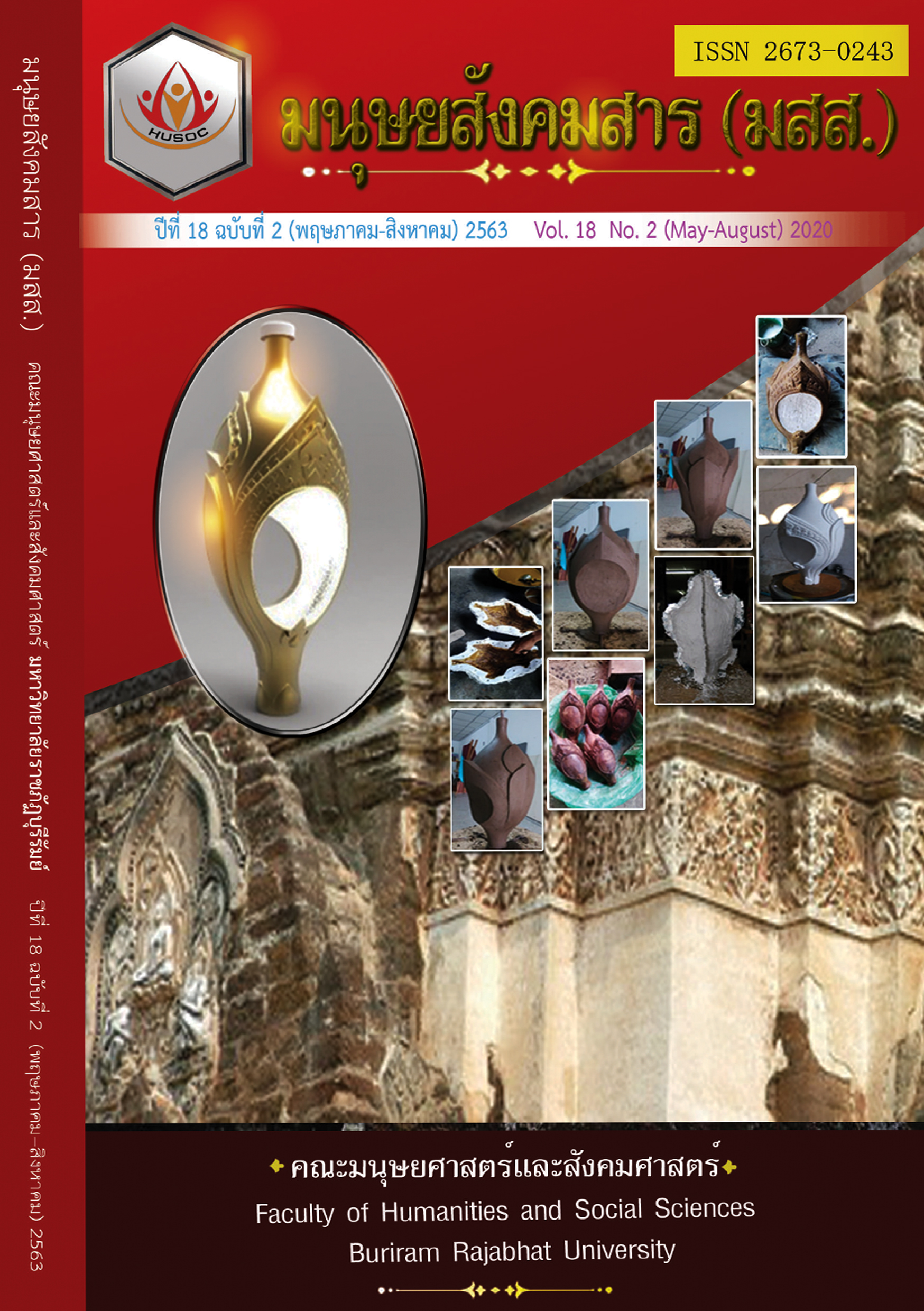A Comparison between Perceptions and Expectations of Instructional Management of English Courses of the General Education Program at Phranakhon Rajabhat University
Main Article Content
บทคัดย่อ
Students enter higher education with expectations which may not always accord with what they actually experience at university. The objectives of this study were to 1) investigate student perceptions and expectations of instructional management of the English courses of the general education program at Phranakhon Rajabhat University. and 2) compare the perceptions to the expectations. The population size was 10,007 individuals comprising non-English majors and non-international college students at this institution. The sample derived through cluster sampling was constituted of 600 individuals, and 505 of them properly completed and returned the questionnaire. The statistics used for data analysis were frequency, percentage, mean, standard deviation, and paired t-test.
The findings were as follows: 1) Concerning the perceptions, the highest rated aspect was the teachers and the lowest one was the learning environment. Regarding expectations, the highest-rated aspect was the teachers, and the lowest-rated one was the learning environment. 2) Every aspect of the perceptions was significantly lower than its respective aspect of the expectations. Moreover, the greatest expectation-perception difference arose in learning environment, and the slightest one in the teachers with p-value of .000.
Article Details
เนื้อหาและข้อมูลในบทความที่ลงตีพิมพ์ในวารสารทดสอบระบบ ThaiJo2 ถือเป็นข้อคิดเห็นและความรับผิดชอบของผู้เขียนบทความโดยตรงซึ่งกองบรรณาธิการวารสาร ไม่จำเป็นต้องเห็นด้วย หรือร่วมรับผิดชอบใดๆ
บทความ ข้อมูล เนื้อหา รูปภาพ ฯลฯ ที่ได้รับการตีพิมพ์ในวารสารทดสอบระบบ ThaiJo2 ถือเป็นลิขสิทธิ์ของวารสารทดสอบระบบ ThaiJo2 หากบุคคลหรือหน่วยงานใดต้องการนำทั้งหมดหรือส่วนหนึ่งส่วนใดไปเผยแพร่ต่อหรือเพื่อกระทำการใดๆ จะต้องได้รับอนุญาตเป็นลายลักอักษรจากวารสารทดสอบระบบ ThaiJo2 ก่อนเท่านั้น
เอกสารอ้างอิง
Assessment. (2015). In the glossary of education reform. Retrieved on 2 February 2020 from https://www.edglossary.org/assessment/
Best, J. W. (1997). Research in education. Englewood Cliffs. New Jersey: Prentice-Hall.
Bitner, M. J., Faranda, W. T., Hubbert, A. R. & Zeithaml, V. A. (1997). Customer contributions and roles in service delivery. International Journal of Service Industry Management, 8(3), 193-205.
Chalardkid, P. (2005). Teaching principles. Bangkok: Kasemsri. [in Thai]
Charuchinda, I., Supawan, S. & In-U-Ris, S. (2019). The course of English for everyday communication: Scores, satisfaction, and cumulative grade point averages. In A. Tapata (ed.), Proceedings of Humanities and Social Sciences: Vol 7 (pp. 202-221). [in Thai]
Churchill, G. A., Jr. (1979). A Paradigm for developing better measures of marketing constructs. Journal of Marketing Research, 16, 64-73.
Clawson, J. G. (2008). Fundamental Elements in Teaching. Retrieved on 3 February 2020 from SSRN: https://ssrn.com/abstract=911821
Content Knowledge. (2016). In the glossary of education reform. Retrieved on 4 February 2020 from https://www.edglossary.org/content-knowledge/
Cuttance, P. (2001). The impact of teaching on student learning. In K. Kennedy (Ed.), Beyond the rhetoric: Building a teaching profession to support quality teaching (pp. 35-55). Australian College of Education: Canberra.
Diett, T. M. & Raghav, M. (2014). Class size matters: Heterogeneous effects of large classes on college student learning. Eastern Economic Journal, 41, 273–283. Retrieved on 5 February 2020 from https://doi.org/10.1057/eej.2014.31
Dulayakasem, U. (2013). General education management. Journal of Learning Innovations, 1(1), 43-52. [in Thai]
Gámez, P. B. (2015). Classroom-based English exposure and English language learners’expressive language skills. Early Childhood Research Quarterly, 31(2), 135-146. Retrieved on 6 February 2020 from https://doi.org/10.1016/j.ecresq.2015.01.007
Harfitt, G. J. (2012). Class size and language learning in Hong Kong: The students’ perspective. Educational Research, 54(3), 331-342. doi/ abs/10.1080/00131881. 2012.710091
Hill, P. (1991). Tangibles, intangibles and services: A new taxonomy for the classification of output. Canadian Journal of Economics, 32(2), 426-446.
Hill, Y., Lomas, L. & McGregor, J. (2003). Students’ perceptions of quality in higher education. Quality Assurance in Education, 11(1), 15–20.
Laird, T. F. N. & Garver, A. K. (2010). The effect of teaching general education courses on deep approaches to learning: How disciplinary context matters. Research in Higher Education, 51(3), 248-265.
Letcher, D.W. & Neves, J.S. (2010). Determinants of undergraduate business student satisfaction. Research in Higher Education Journal, 1-26.
Mala, D. (2019, January 4). Thai university struggle to keep up. Bangkok Post. Retrieved on 7 February 2020 from from https://www.bangkokpost.com
Parasuraman, A. Berry, L. & Zeithaml, V. (1991). Understanding Customer Expectations of Service. Sloan Management Review, 32. 39-48.
Parasuraman, A., Zeithaml, V. A. & Berry, L.L. (1985). A conceptual model of service quality and its implications for future research. The journal of Marketing, 49(4), 41-50.
Parasuraman, A., Zeithaml, V. A. & Berry, L. L. (1988). SERVQUAL: A multiple-item scale for measuring consumer perceptions of service quality, Journal of Retailing, 64(1), 12-40.
Sakthivel, P.B., Rajendran, G. & Raju, R. (2005). TQM implementation and students’ satisfaction of academic performance. The TQM Magazine, 17(6), 573-589.
Seel, N.M. (2012). Learning environment. In N.M Seel (Ed.), Encyclopedia of the Sciences of Learning. Retrieved on 8 February 2020 from https://doi.org/10.1007/978-1-4419-1428-6_1860
Tawara, W., Ruangchan, S., Siriwong, P., Apanutat, P., Hatasak, M., Phungnak, P., Athittang, . . . Suankratai, C. (2013). A Report on the General Education Framework in Line with Thai Qualifications Framework for Higher Education (TQF: Hed). Bangkok: The Office of Higher Education Committee.
Todd. R. W. (2006). Why investigate large classes? rEFLections, 9(10), 1-12.
Watanapokakul, S. (2016). The perceptions and experiences of English teachers regarding large EFL classes. LEARN Journal, 9(2), 199-219.
Yildiz, S. M. & Kara, A. (2014). Developing alternative measures for service quality in higher education: Empirical evidence from the school of physical education and sports sciences. In Jr. L. Robinson (Ed.), Proceedings of the 2009 Academy of Marketing Science (AMS) Annual Conference. Retrieved on 9 February 2020 from https://doi.org/10.1007/978-3-319-10864-3_102
Yousapronpaiboon, K. (2014). SERVQUAL: Measuring higher education service quality in Thailand. Procedia-Social and Behavioral Science, 116. 1088- 1095.
Zeithaml, V. A. & Bitner, M. J. (1997). Service marketing: Integrating customer focus across the firm. Boston: McGraw-Hill.
Zhao, X. (2012). A review on service quality and student satisfaction. In J. Luo (Ed.), Soft Computing in Information Communication Technology. Advances in Intelligent and Soft Computing: Vol 158. 115-122. Retrieved on 10 February 2020 from https://doi.org/10.1007/978-3-642-29148-7_17


